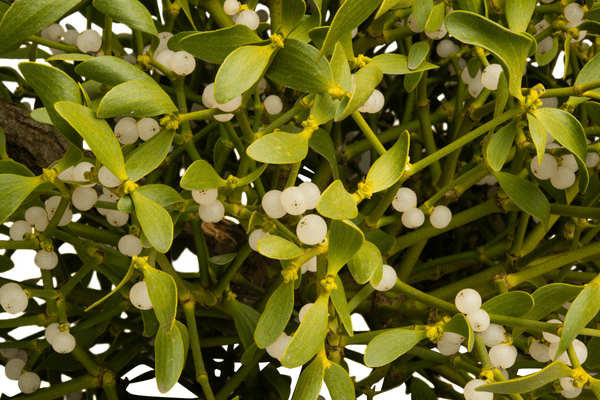Mistletoe as a Supportive Therapy for Cancer
Mistletoe is among the most prescribed herbal medicine for cancer in Europe, where it is often integrated into conventional oncology treatment programmes.
In low doses, mistletoe stimulates and activates the immune system, it modulates the immune response and has direct anti-cancer effects. It helps the innate immune system work more efficiently and increases white blood cells and natural killer (NK) cells. NK cells directly recognise and break down stressed, unhealthy cancer cells and release anti-tumour cytokines. NK cell numbers may be lowered by radiotherapy and chemotherapy.
The Evidence for Mistletoe
There are more than 140 clinical studies of its use in cancer, including randomised controlled trials. While there are some limitations in the design and method, a relatively consistent finding is a reduction in the adverse effects of chemotherapy and radiotherapy and/or improvement in the quality of life.
A summary of the evidence and patient experiences of Mistletoe therapy are described here and here.
Mistletoe as a Medicinal Plant
Mistletoe (Viscum album L) has a long tradition of use as a medicinal plant, and for at least the last century, used as adjuvant therapy in cancer care.
The concentration of active substances varies by the mistletoe-bearing host tree, and the season, for example, summer and winter. Mistletoe is harvested twice a year, and fermented extracts mixed to produce a balance of viscotoxins and mistletoe lectins.
The ball-shaped mistletoe bushes, connect to the water transport system of the host tree to obtain water, minerals, and other nutrients by so-called haustorium in the branches. The white berries, from inconspicuous flowers, are eaten by birds, who then spread the mistletoe. The water drawn up from the ground by each type of tree is the basis for the host-depending qualities of mistletoe.
Rhythms of Mistletoe
A rhythmic therapeutic approach reflects the natural and seasonal rhythms of the growth of young mistletoe, with synchronous swinging motions seen in late May until late June. Mistletoe is thought to enhance inner warmth, restore balance to systems and encourage a greater sense of clarity and connection to self, purpose, and the natural rhythms of life.
An Integrative and Individualised Approach
As an integrative therapy, mistletoe is best used within a patient-centered and evidence-informed approach to healthcare. In practice this means that a consultation with a clinician ensures the most appropriate preparation is combined with conventional, holistic, and lifestyle therapies.
The active substances within the plant, individual characteristics, type, and site of cancer are carefully considered in the selection and prescription of mistletoe.
ISCADOR
The preparations of mistletoe we use are manufactured by Iscador, which sustainably cultivates the mistletoe plant under natural and protected conditions in Switzerland, Germany, and France.
Mistletoe is a prescription-only medicine in the UK and is not readily available within the health service. Iscador is prescribed here as oral therapy or subcutaneous injections.
There are five different preparations and these are based on the host trees Apple (Malus, M), Oak (Quercus, Qu), Pine (Pinus, P), and Elm (Ulmus, U).
Iscador may be used as a supportive therapy at any stage of cancer, from the time of diagnosis, treatment, and even longer-term to reduce the risk of recurrence. For example, when taking a preparation of Iscador by mouth, treatment may be for 12 months or more.
A change in subjective well-being with Iscador, may be experienced as improved appetite, sleep, energy, mood, and sensation of inner warmth. However, it can take time to reach a therapeutically optimal dose, when injected, and mistletoe is not recommended as a treatment for acute pain.
Safety
Iscador may be safely integrated with standard methods of cancer treatment, such as surgery, chemo-, radio-, immune and/or hormone therapies.
Adverse reactions to Iscador are extremely rare and studies have not found any interactions with other cancer treatments and chemotherapeutic drugs. Some patients have reported flu-like symptoms, feeling unwell, gastrointestinal upset, and skin rashes and very few react with systemic side effects to subcutaneous injections of Iscador.
Mistletoe Therapy at NCIM
Three of our Holistic Doctor team at NCIM can prescribe oral Iscador, two of which can also administer subcutaneous preparations.
If you’d like to explore the possibility of Mistletoe Therapy to support your cancer treatment please make an appointment with one of our Holistic Doctors: Dr Elizabeth Thompson, Dr Roger Smith or our Holistic Pharmacist Kiriaki Marselou. We have face to face and online appointments available.
To learn more about Mistletoe Therapy at NCIM click here.
Mistletoe therapy isn’t an alternative treatment and we always encourage patients to discuss the use of Mistletoe with their Oncology team or General Practitioner.

